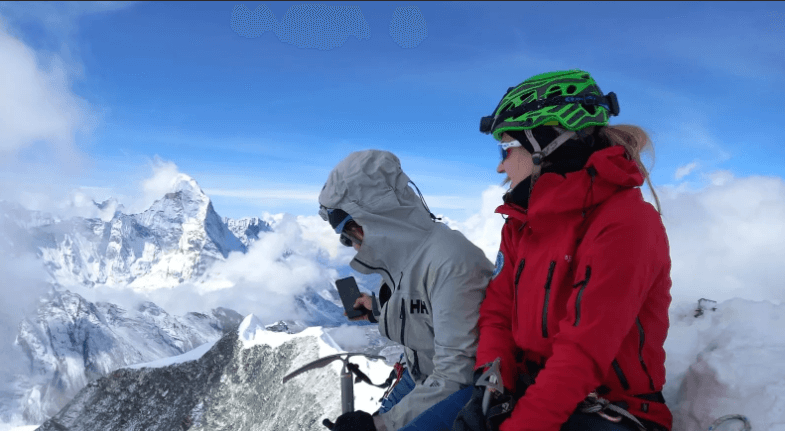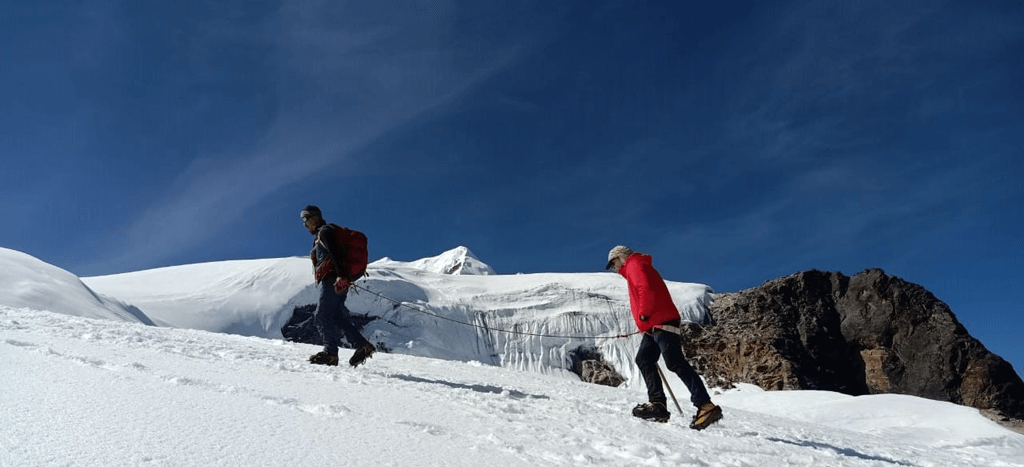17th June, 2025

May 06, 2024
Island Peak Climbing In March
- I am a Beginner Climber, Can I Do This Climb?
- How Hard is Climb Island Peak?
- Distance of Island Peak
- Why Island Peak in March
- What Time of Year is Best to Climb Island Peak?
- What is the Weather Like on Island Peak in March?
- How Long Does It Take to Climb Island Peak?
- What are the Challenges of Climbing Island Peak in March?
- Suggestions for Your Island Peak Climbing in March Trip
- Highlights of Island Peak Climbing in March
- How To Reach Island Peak?
- Island Peak Climbing Duration
- Permit for Island Peak Climbing
- Final Say
- Island Peak Climbing Packages
Island Peak climbing in March presents a captivating adventure set amidst the early days of spring in the Everest region of Nepal. March marks the transition from winter to spring, offering climbers favorable weather conditions and stunning vistas of the Himalayan landscape awakening from its snowy slumber.
During March, climbers can expect clear skies, mild temperatures, and stable weather patterns conducive to trekking and climbing. Daytime temperatures at lower altitudes like Lukla and Namche Bazaar range from 10°C to 15°C (50°F to 59°F), making for comfortable trekking conditions. As climbers ascend higher towards Island Peak Base Camp and beyond, temperatures gradually decrease, requiring warmer clothing layers and proper gear.
The journey to Island Peak typically begins with a scenic flight from Kathmandu to Lukla, followed by a trek through lush rhododendron forests, Sherpa villages, and scenic river valleys. The trail offers opportunities to immerse oneself in Sherpa culture, visit ancient monasteries, and enjoy panoramic views of iconic peaks like Everest, Lhotse, and Ama Dablam.

Island Peak Expedition 14 Days
The Island Peak Expedition is an exhilarating mountaineering adventure that takes climbers to the summit of Island Peak, also known as Imja Tse. The peak is located in the Khumbu region of Nepal and s...
At Island Peak Base Camp, climbers prepare for the summit push, which involves crossing icy moraines and ascending steep snow slopes. The final ascent to the summit includes negotiating crevasses and requires the use of basic mountaineering equipment such as crampons, ice axes, and ropes.
Standing atop Island Peak's summit at 6,189 meters (20,305 feet) rewards climbers with unparalleled 360-degree views of the Himalayan peaks stretching into Tibet. The descent back to Base Camp and subsequent return trek through familiar trails complete a journey filled with achievement, natural beauty, and cultural exploration.
March presents an ideal window for climbing Island Peak, combining favorable weather conditions, scenic beauty, and a challenging yet achievable summit goal in the heart of the world's highest mountain range.
I am a Beginner Climber, Can I Do This Climb?
As a beginner climber, embarking on the ascent of Island Peak is indeed achievable with proper preparation and guidance. Island Peak is classified as a trekking peak rather than a technical climb, making it accessible to climbers with basic mountaineering skills and a good level of physical fitness.
Preparation is key. It's advisable to join a guided expedition led by experienced Sherpa guides who provide essential support, including route planning, equipment rental, and safety management. They offer training in basic mountaineering techniques such as using crampons, ice axes, and ropes, ensuring climbers are well-equipped for the journey.

Island Peak Expedition 15 Days
Island Peak Climbing is an exciting adventure that takes climbers to the summit of Island Peak, also known as Imja Tse. The peak is located in the Khumbu region of Nepal and stands at an elevation of...
Training should focus on building cardiovascular endurance, lower body strength, and mental resilience to cope with the physical demands of high-altitude trekking. Practice hikes with elevation gain and simulated altitude training can simulate the conditions climbers will face on Island Peak.
With determination, willingness to learn, and adherence to safety protocols, beginners can successfully summit Island Peak. The journey offers not only a physical challenge but also an opportunity for personal growth, cultural immersion, and the thrill of conquering a 6,189-meter peak in the Himalayas.
How Hard is Climb Island Peak?
Climbing Island Peak is considered moderately challenging. While not as technically demanding as some of the higher peaks in the region, it requires climbers to navigate through rocky trails, snow-covered slopes, and glaciers. The final ascent involves ascending a steep snow and ice slope, known as the headwall, which requires the use of crampons, ice axes, and ropes.
The difficulty of the climb is primarily influenced by the high altitude, which can pose challenges such as reduced oxygen levels and increased risk of altitude sickness. Proper acclimatization, physical fitness, and mental preparation are crucial for a successful summit attempt.
Experienced Sherpa guides play a vital role in ensuring safety and guiding climbers through technical sections. They monitor climbers for signs of altitude sickness and adjust the itinerary as needed to maximize chances of success.
Overall, while Island Peak is manageable for climbers with previous trekking experience and basic mountaineering skills, it requires careful preparation and respect for the challenges posed by high-altitude mountain environments.

Island Peak Summit Return By Helicopter
Many of us only dream of standing on a tall peak looking down on the world. This is a great climb that will satisfy this desire. Island Peak, also referred to as Imja Tse, is a 6187-meter high peak in...
Distance of Island Peak
The distance to Island Peak varies depending on the trekking route chosen and starting point. Generally, the trek from Lukla to Island Peak Base Camp covers approximately 40-50 kilometers (25-31 miles) one way.
The journey begins with a scenic flight from Kathmandu to Lukla, followed by a trek through picturesque Sherpa villages like Namche Bazaar, Tengboche, and Dingboche. These villages provide essential acclimatization stops and opportunities to experience Sherpa culture.
From Dingboche, climbers ascend towards Island Peak Base Camp, passing through diverse terrain including yak pastures, moraines, and glaciers. The trek to Base Camp typically takes around 3-4 days, allowing climbers to acclimatize gradually to increasing altitudes.
The final ascent to the summit of Island Peak involves negotiating steep snow and ice slopes, followed by a descent back to Base Camp. The total distance covered during the climb varies based on individual pace, weather conditions, and acclimatization needs.
Why Island Peak in March
March is considered one of the best times to climb Island Peak due to favorable weather conditions and fewer crowds compared to peak seasons. As spring begins in the Everest region, climbers can expect clear skies, mild daytime temperatures, and stable weather patterns conducive to trekking and climbing.
The trails are less congested, offering a more peaceful and immersive experience amidst the pristine Himalayan landscapes. March also provides excellent visibility for enjoying panoramic views of Everest, Lhotse, and Ama Dablam from various vantage points along the trek.
The stable weather in March reduces the risk of precipitation and snowfall, ensuring safer and more enjoyable trekking conditions. It's an ideal time for climbers seeking to summit Island Peak while experiencing the beauty of Nepal's natural scenery and cultural heritage.

19 Days Everest Base Camp with Island Peak Climbing
This is a must for those adventurers–seekers who are physically fit or have previous climbing experience. This is one adventure that will make your toes curl and give you an adrenalin rush as you clim...
What Time of Year is Best to Climb Island Peak?
The best time of year to climb Island Peak is typically during the pre-monsoon (spring) and post-monsoon (autumn) seasons. In spring, from March to May, climbers benefit from mild temperatures, clear skies, and blooming rhododendrons along the trekking routes. The stable weather conditions in spring enhance visibility and reduce the risk of avalanches and heavy snowfall.
Similarly, autumn, from September to November, offers favorable weather with clear skies and stable temperatures, making it another popular season for climbing. Autumn also provides stunning views of the Himalayan peaks amidst vibrant autumn colors and festivals celebrated by local communities.
Both seasons provide optimal conditions for climbing Island Peak, allowing climbers to enjoy breathtaking views, cultural experiences, and a challenging yet rewarding ascent in the heart of the Everest region.
What is the Weather Like on Island Peak in March?
March heralds the onset of spring in Nepal's Everest region, bringing a transition from the cold of winter to milder temperatures and more stable weather patterns. Climbing Island Peak in March offers climbers relatively clear skies, mild daytime temperatures, and the opportunity to witness the landscape awakening from its winter slumber.
During March, temperatures at lower altitudes like Lukla and Namche Bazaar range from 5°C to 15°C (41°F to 59°F), gradually decreasing as climbers ascend higher towards Island Peak Base Camp and beyond. While daytime temperatures are pleasant, nighttime temperatures can drop below freezing, necessitating warm clothing layers and suitable gear.
The stable weather in March reduces the likelihood of heavy snowfall and precipitation, enhancing visibility for panoramic views of the surrounding Himalayan peaks, including Everest, Lhotse, and Ama Dablam. However, climbers should be prepared for sudden weather changes typical of mountainous regions.

EBC TREK WITH ISLAND PEAK CLIMBING
This exhilarating and unforgettable trek for adventure seekers takes you to the summit of "Island Peak (6,189m) situated between Amadablam and Lhotse mountains. This amazing adventure is packed full o...
How Long Does It Take to Climb Island Peak?
The duration to climb Island Peak varies depending on several factors, including the chosen route, climber's fitness level, acclimatization schedule, and weather conditions. Generally, the itinerary for climbing Island Peak spans approximately 15 to 20 days round trip from Kathmandu.
The journey begins with a scenic flight from Kathmandu to Lukla, followed by a trek through Sherpa villages and picturesque landscapes to reach Island Peak Base Camp. This initial trekking phase typically takes around 7 to 10 days, allowing climbers to acclimatize gradually to increasing altitudes.
From Base Camp, climbers undertake a summit push, which involves ascending steep snow and ice slopes, crossing crevasses, and navigating technical terrain using climbing equipment such as crampons, ice axes, and ropes. The summit day itself can take 10 to 12 hours, depending on weather conditions and the pace of the climbers.
After successfully summiting Island Peak, climbers descend back to Base Camp and subsequently trek back to Lukla over several days. The entire expedition concludes with a flight back to Kathmandu, marking the end of a challenging yet rewarding adventure in the Himalayas.
What are the Challenges of Climbing Island Peak in March?
Climbing Island Peak in March presents unique challenges influenced by the transitional weather conditions in the Everest region as winter gives way to spring.
- Weather Variability: March experiences fluctuating weather patterns, ranging from clear skies and mild temperatures to occasional snowfall or cloudy conditions. Climbers must be prepared for rapid weather changes that can affect visibility and climbing conditions.
- Cold Temperatures: Although temperatures begin to rise, especially during the daytime, nights and higher altitudes can still be cold. Proper layering and insulation are crucial to stay warm during rest periods and summit attempts.
- Snow and Ice Conditions: Snow and ice on the mountain can vary in consistency and stability during March. Crevasses and icy slopes require careful navigation and the use of technical climbing equipment such as crampons, ice axes, and ropes.
- Altitude and Acclimatization: Rapid altitude gains without adequate acclimatization increase the risk of altitude sickness. Climbers should plan for gradual ascent, incorporating rest days and hydration to allow their bodies to adjust to decreasing oxygen levels.
- Logistical Challenges: The logistics of organizing a climbing expedition in the Everest region, including permits, accommodations, and transportation, require careful planning due to varying availability and weather-dependent flight schedules to Lukla.

ISLAND PEAK CLIMBING
This is a fantastic climbing expedition that takes you to the summit of "Island Peak (6,189m) situated between Amadablam and Lhotse mountains. This exciting adventure is jam-packed full of features an...
Suggestions for Your Island Peak Climbing in March Trip
To ensure a successful and enjoyable climbing expedition to Island Peak in March, consider the following suggestions:
- Start Early: Begin your trek early in the day to take advantage of clearer morning weather and maximize daylight hours for trekking and climbing.
- Pack Proper Gear: Pack appropriate clothing layers for cold temperatures, including thermal base layers, insulated jackets, waterproof outerwear, gloves, hats, and sturdy trekking boots. Ensure all gear is tested and in good condition before departure.
- Monitor Weather Conditions: Stay informed about weather forecasts and be prepared for changes in weather patterns. Carry essential gear for rain, snow, and wind protection, and be ready to adjust your itinerary if weather conditions deteriorate.
- Acclimatization Plan: Incorporate acclimatization days into your itinerary to allow your body to adjust gradually to higher altitudes. Stay hydrated, avoid alcohol, and monitor each team member's health for signs of altitude sickness.
- Travel with Experienced Guides: Engage experienced Sherpa guides who are familiar with the route, weather conditions, and safety protocols. They can provide valuable insights into navigating the mountain terrain and ensure a safe and successful summit attempt.
- Respect Local Culture: Embrace the opportunity to interact with Sherpa communities along the trekking route. Respect local customs, support local businesses, and learn about the rich cultural heritage of the Everest region.
By preparing meticulously, respecting the challenges presented by Island Peak's terrain and weather in March, and following expert guidance, you can enhance your chances of a rewarding summit experience. Enjoy the beauty of the Himalayas and the sense of achievement that comes with reaching Island Peak's summit during this dynamic and exhilarating time of year.
Highlights of Island Peak Climbing in March
Climbing Island Peak in March offers a blend of adventure, natural beauty, and cultural immersion in Nepal's Everest region. Here are the key highlights of embarking on this journey during this month:
- Ideal Weather Conditions: March marks the beginning of spring in the Everest region, characterized by clear skies, mild temperatures, and stable weather patterns. These conditions create optimal trekking and climbing conditions, with reduced chances of precipitation and snowfall.
- Scenic Landscapes: The trek from Lukla to Island Peak Base Camp is adorned with blooming rhododendrons, adding vibrant hues to the landscape. Climbers traverse through lush forests, picturesque Sherpa villages like Namche Bazaar and Tengboche, and scenic river valleys, providing ample opportunities for photography and cultural immersion.
- Panoramic Views: Throughout the trek, climbers are treated to panoramic views of some of the world's highest peaks, including Everest, Lhotse, Nuptse, and Ama Dablam. The vistas from higher altitudes become clearer as the skies remain mostly unobstructed during March, offering breathtaking sights that inspire awe and admiration.
- Cultural Exploration: March allows climbers to engage with local Sherpa communities and witness their unique way of life. Visits to ancient monasteries, prayer flags fluttering in the breeze, and interactions with friendly Sherpa villagers enrich the cultural experience of climbing Island Peak.
- Achievement of Summit: Standing atop Island Peak's summit at 6,189 meters (20,305 feet) is a monumental achievement. The panoramic views from the summit stretch across the Himalayan range, rewarding climbers with a sense of accomplishment and a memory to cherish for a lifetime.
Climbing Island Peak in March combines the thrill of adventure with the tranquility of nature and the warmth of Sherpa hospitality, making it a memorable journey that captures the essence of the Himalayas in springtime.

MERA PEAK CLIMBING
This is an excellent opportunity to climb Nepal’s highest peak without having to obtain a permit (6,476m/21,190ft). From the summit, you will have stunning views of several 8000m plus peaks, such as E...
How To Reach Island Peak?
Reaching Island Peak involves a multi-day trek through the Everest region of Nepal, starting with a flight from Kathmandu to Lukla, the gateway to the Khumbu region. From Lukla, climbers trek through picturesque Sherpa villages, dense forests, and rugged terrain towards Island Peak Base Camp.
- Flight to Lukla: The journey begins with a thrilling 30-minute flight from Kathmandu to Lukla, offering spectacular views of the Himalayas (weather permitting).
- Trekking Route: The trek from Lukla to Island Peak Base Camp typically takes around 7 to 10 days, depending on the chosen itinerary and acclimatization schedule. The route passes through villages like Namche Bazaar, Tengboche, and Dingboche, each offering unique cultural experiences and essential acclimatization stops.
- Final Approach to Base Camp: From Dingboche, climbers ascend towards Island Peak Base Camp, navigating yak pastures, moraines, and glaciers. The final approach involves crossing the Kongma La Pass before reaching Base Camp.
- Summit Attempt: After adequate rest and acclimatization at Base Camp, climbers undertake a summit push, ascending steep snow and ice slopes to reach the summit of Island Peak.
Island Peak Climbing Duration
The duration for climbing Island Peak typically spans approximately 15 to 20 days, encompassing the trekking and climbing phases from Kathmandu and back. Here's a breakdown of the itinerary:
- Flight to Lukla: Day 1 involves a flight from Kathmandu to Lukla, followed by trekking to Phakding or Monjo.
- Trek to Namche Bazaar: Days 2-3 include trekking to Namche Bazaar, a key acclimatization stop.
- Trek to Dingboche: Days 4-5 involve trekking to Dingboche, another acclimatization stop.
- Trek to Island Peak Base Camp: Days 6-10 are spent trekking from Dingboche to Island Peak Base Camp, with stops at Lobuche and Gorak Shep.
- Summit Push: Days 11-12 typically involve ascending to High Camp and making a summit attempt on Island Peak.
- Descent and Return: Days 13-15 include descending back to Lukla via the same route and flying back to Kathmandu.

LOBUCHE PEAK CLIMBING
This is a real mountain climbing adventure that will leave you in awe of the beauty of the Himalayan Mountains. The Lobuche Peak Climbing expedition in the Khumbu region of Nepal has been ranked by Lo...
Permit for Island Peak Climbing
To climb Island Peak, climbers require specific permits issued by the Nepalese government and local authorities. The permits needed include:
- Sagarmatha National Park Permit: This permit is mandatory for entering the Sagarmatha National Park, where Island Peak is located. It helps fund conservation efforts and ensures sustainable tourism practices in the region.
- Island Peak Climbing Permit: Climbers must obtain a special climbing permit for Island Peak from the Nepal Mountaineering Association (NMA). This permit includes fees based on the season and nationality of the climber.
- TIMS Card (Trekker's Information Management System): This card is required for all trekkers entering the Everest region and helps authorities track and manage visitor information.
Obtaining these permits typically involves working with a licensed trekking agency or guide who handles the paperwork and ensures compliance with local regulations.
Final Say
Climbing Island Peak in April offers adventurers a unique opportunity to explore the natural beauty and cultural richness of Nepal's Everest region while tackling a challenging yet achievable summit. With favorable weather conditions, stunning views, and the support of experienced guides, climbers can embark on a rewarding journey that combines personal achievement with unforgettable Himalayan experiences. Proper preparation, including physical training, acclimatization, and obtaining necessary permits, ensures a safe and enjoyable expedition to Island Peak, leaving climbers with lasting memories of their Himalayan adventure.

Mera Peak Climbing 20 Days
This is the highest peak in Nepal that does not require a climbing permit (6,476m/21,190ft). From the summit there are spectacular views of several 8000 meter plus peaks, such as Everest, Cho Oyu, Kan...
Island Peak Climbing Packages
Island Peak Summit Return By Helicopter
Island Peak Expedition 14 Days
Island Peak Expedition 15 Days
Everest Three Pass with Island Peak Climbing
Island And Lobuche Peak Climbing

Mera Peak Climbing 15 Days
Mera Peak Expedition is a popular trekking route that offers a challenging climb to the summit of Mera Peak. The peak stands at an elevation of 6,476 meters (21,247 feet) and is located in the Solu Kh...
Any Questions? Let Us Know.
Recent Posts
14th June, 2025
12th June, 2025




















